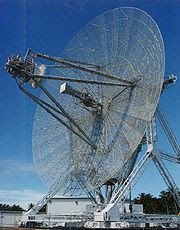
Radar
Radar is an object detection system that uses electromagnetic waves to identify the range, altitude, direction, or speed of both moving and fixed objects such as aircraft, ships, motor vehicles, weather formations, and terrain. The term RADAR was coined in 1941 as an acronym for radio detection and ranging.[1][2][3][4] The term has since entered the English language as a standard word, radar, losing the capitalization. Radar was originally called RDF (Radio Direction Finder, now used as a totally different device) in the United Kingdom. It is the only word in the English language that is both an acronym and a palindrome[citation needed].
A radar system has a transmitter that emits microwaves or radio waves. These waves are in phase when emitted, and when they come into contact with an object are scattered in all directions. The signal is thus partly reflected back and it has a slight change of wavelength (and thus frequency) if the target is moving. The receiver is usually, but not always, in the same location as the transmitter. Although the signal returned is usually very weak, the signal can be amplified through use of electronic techniques in the receiver and in the antenna configuration. This enables radar to detect objects at ranges where other emissions, such as sound or visible light, would be too weak to detect. Radar uses include meteorological detection of precipitation, measuring ocean surface waves, air traffic control, police detection of speeding traffic, determining the speed of basesballs and by the military.
A radar system has a transmitter that emits microwaves or radio waves. These waves are in phase when emitted, and when they come into contact with an object are scattered in all directions. The signal is thus partly reflected back and it has a slight change of wavelength (and thus frequency) if the target is moving. The receiver is usually, but not always, in the same location as the transmitter. Although the signal returned is usually very weak, the signal can be amplified through use of electronic techniques in the receiver and in the antenna configuration. This enables radar to detect objects at ranges where other emissions, such as sound or visible light, would be too weak to detect. Radar uses include meteorological detection of precipitation, measuring ocean surface waves, air traffic control, police detection of speeding traffic, determining the speed of basesballs and by the military.
